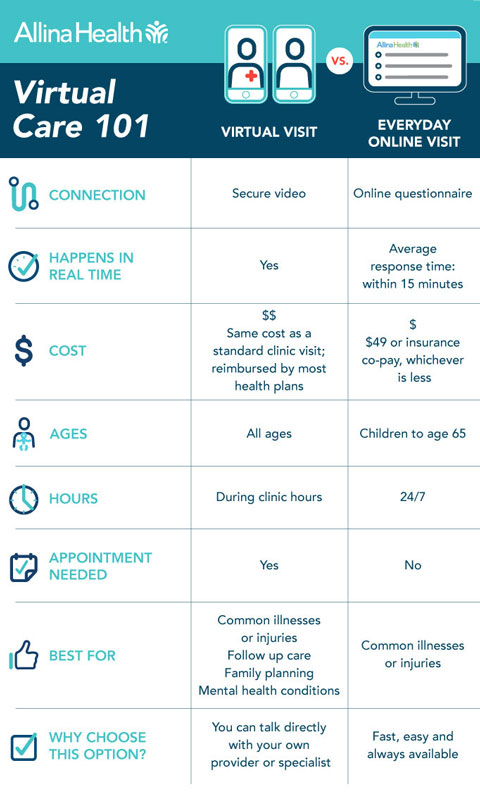CARE
Six reasons virtual care may be better than in-person care
- Many patients who try virtual care find they prefer it for much of their care.
- Some types of virtual care are scheduled appointments that take place during clinic regular hours, while other types are available 24/7.
- Virtual care costs about the same or less than an office visit, and most health insurance plans offer reimbursement for virtual care.
Virtual health care is gaining popularity, especially as we adapt many of our activities and routines to social distancing.
Virtual care allows you to get medical care without having to go to a clinic. That saves you time and also means less exposure to waiting room germs.
There are different types of virtual care, but two of the most common are virtual visits (also called telehealth or telemedicine) and online or e-visits.
- Virtual visits happen in real time through a secure video connection with your provider. You and your provider discuss your concerns and next steps, much like you would during a regular office visit.
- Online visits involve completing an online questionnaire about your symptoms. A provider reviews your responses and later provides you with a treatment plan.
As you might expect, virtual care can’t always take the place of an in-person visit to your provider. But you may be surprised to learn that most clinic visits can be done through a virtual care option. In fact, many patients who try virtual care find that they prefer it for much of their care. Here’s why:
1. Care comes to you
- In rural areas, it can save a long road trip to see your primary doctor and even some specialists. City dwellers also appreciate virtual care: no need to fight traffic, get delayed by road construction or look for parking.
- You can stay home, which is ideal during the coronavirus pandemic.
- It makes your life easier – less time off work and less stress getting to the appointment on time.
- Some people find that they are more relaxed when they can see their provider from home. That makes the conversation with their provider easier and more productive.
2. Wait at home – not in a clinic
- Virtual care means you skip the physical waiting room and go about your day until you start the visit.
- There’s no need to surround yourself with other sick people, which is especially important if you are older or have a weakened immune system.
3. More access, more choices
- Virtual care makes health care delivery more efficient, helping everyone get the care they need more quickly.
- Regular check-ups may be easier to fit into your schedule when they take place virtually, which is a benefit if you have a condition that requires close monitoring.
- Some virtual care options, like online visits, are available 24/7, so you can get help on weekends and after hours for many common health conditions.

Here is the infographic comparing virtual visits with Everyday Online visits in an alternative format.
4. Cost is comparable to a regular office visit, and in some cases, cheaper
- Most health insurance plans offer reimbursement for virtual care options, and some may even offer smaller co-payments for online care.
- Most providers won’t charge for virtual care if it is determined that you need to be seen in person.
5. Easy to fill your prescriptions and track the details of your visit
- New prescriptions or refills are sent electronically to your pharmacy.
- You have a secure way to review the results of your visit and any instructions from your provider.
6. No need to be a tech whiz
- If you can download an app from your smart device’s mobile app store, you can do a virtual visit. Set up the app with your login name, password and a web connection – and you’re ready.
- Online visits are as simple as filling out an online survey, with space to include written comments if needed. Click submit and you’ll hear back from a provider shortly.
MORE LIKE THIS
Recipe: Fruit and quinoa salad
Posted August 18, 2020
This easy, healthy salad is good for your heart, is gluten free, and low in sodium. Its bright, beautiful color is a hint that it contains antioxidants, which help reduce your risk of cancer. You can also add other seasonal fruits to this salad such as kiwi, cantaloupe, peaches, raspberries or watermelon.
Continue reading







